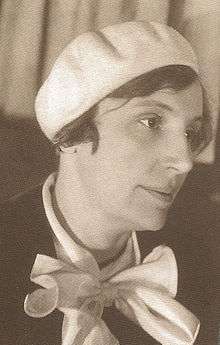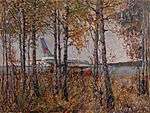Olga Zhekulina
| Olga Zhekulina О́льга Жеку́лина | |
|---|---|
 | |
| Born | 4 October 1900 |
| Died | 5 August 1973 |
| Known for | Painter, puppeteer |
| Patron(s) | Konstantin Yuon, Konstantin Korovin |
Olga Anatolyevna Zhekulina (Russian: О́льга Анато́льевна Жеку́лина) (4 October 1900 — 5 August 1973) was a noted Russian painter and one of the famous Soviet puppeteers.[1][2]
She was a member of the Moscow Union of Artists.[3]
Biography
Olga Zhekulina was born in 1900 in a noble family. Originally she received art education in the private studio of the famous Russian artist Konstantin Yuon, where she studied until 1917.
In 1918-1921, she studied at the Free Art Studios of Konstantin Korovin[3] (since 1921 - Vkhutemas). In 1921, she was expelled from Zhekulina Art Workshops for her non-proletarian origin.
Serious creative activity of the artist began at the turn of the 1910s and 20s.[4]
In the 20s Zhekulina participated in the life of the "Fire-color" Association, which also consisted of Arkhipov, Bogorodskiy, Dobuzhinsky, Petrov-Vodkin, Voloshin, and other major artists of the time. The main motives of the artist in painting during this period were - "hut buried in the snow, spring, silver gave summer".[4]

In 1930, she became known for the scenery of "A trivial comedy for serious people" by Oscar Wilde for a branch of the Maly Theater.[3]
After that, she worked for nearly twenty years as the puppet theater artist of the Moscow House of Pioneers.[3]
In the 1950s, She became a member of the Moscow Union of Artists.[5] In the late 1950s Zhekulina working on a major state order: a series of landscapes of the Red Presnya.
In the 1960s, the artist was working on a "Valdai cycle", dedicated to the Russian village.
The artist died in 1973.[5] During her life, the artist created some 200 works.
Family
Her father was a district agronomist, and then a banker. He was repressed.
The older brother Sergey was a professor of psychology. The younger brother Leo was a famous scientist and engineer, author of hundreds of scientific papers. Leo worked with Sergei Korolev.
Works
|
Further reading
- Т. Клюева. Ольга Анатольевна Жекулина, 1900-1973. Советский художник, 1977
- В.Г.Азаркович. Выставки советского изобразительного искусства: 1954-1958 гг. Сов. художник, 1981
- В.Д.Соловьëв. Русские художники ХVIII-ХХ веков. Эксперт-Клуб, 2005
- Ольга Жекулина (1900-1970) / Антикварное обозрение, №1. Спб.: 2007
References
- ↑ "№39 (693) / Искусство и культура / Художественный дневник / Выставка / Куклы, приятные во всех отношениях". Itogi.ru. 2010-12-29. Retrieved 2013-10-05.
- ↑ https://web.archive.org/web/20120728171024/http://painters.artunion.ru/2-07.htm. Archived from the original on July 28, 2012. Retrieved May 17, 2013. Missing or empty
|title=(help) - 1 2 3 4 "АртРу.инфо - Персоны - Жекулина Ольга Анатольевна". Artru.info. Retrieved 2013-10-05.
- 1 2 п⌡п╟я─п╦я│п╟ п═я┌п╦я┴п╣п╡п╟ п╦я│п╨я┐я│я│я┌п╡п╬п╡п╣п╢. "п≈п╬п╩п╬я┌п╟я▐ п÷п╟п╩п╦я┌я─п╟: "...п≤п╫я▀п╪ п╬я┌п╨я─я▀п╡п╟п╣я┌я│я▐ я┌п╟п╧п╫п╟, п╦ п©п╬я┤п╦п╣я┌ п╫п╟ п╫п╦я┘ я┌п╦я┬п╦п╫п╟Б─╕"". Zolotayapalitra.ru. Retrieved 2013-10-05.
- 1 2 "Галерея Советского Искусства". Art-media.su. Retrieved 2013-10-05.


